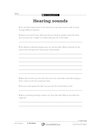Investigating sound waves
Add to My Folder
Investigate how sound travels through waves and is measured in decibels
Sound is a phenomenon that children so easily appreciate. They can hear it, often feel it and even, on occasions, see the effects of it. Standing on the platform when an express train rushes through the station or close to the amplification system at a pop concert, sound levels can be high enough to cause damage. Yet even in quieter moments some sounds also reach our ears, whether it is the rustling of a paper tissue or the sound of our own breathing.
Essential facts
- Sound travels as waves of vibration through atoms and molecules that make up substances. As each atom and molecule vibrates, they bump into others making them vibrate as well. Sound cannot travel in a vacuum, though, because there are no atoms and molecules to pass on the energy.
- The reflected sound waves that bounce off hard surfaces are called an echo. The harder and smoother the surface, the louder the echo will be. Sound also travels fast far underwater. A sonar system sends out pulses of sound waves through water and detects any returning echoes.
- The loudness of sound is measured in decibels (dB). The blue whale is the loudest animal in the world. It is able to produce sounds up to 188dB.
- A radio works by receiving modulated radio waves through its aerial, which it converts back into very weak electrical signals. The signal is strengthened (amplified) and a loudspeaker turns it into a sound that can be heard.
- When a sound source moves in relation to the listener, the pitch of the sound alters. If the sound source moves towards the listener, the pitch gets higher because the sound waves are bunched together in front of it and increase in frequency. If the sound source moves away from the listener, the pitch gets lower because the sound waves spread out and decrease in frequency. The change in pitch is particularly noticeable in the sirens of emergency vehicles. This change in pitch is called the Doppler effect, after the Austrian scientist Christian Doppler (1803-1853), who first described it.
Member-only content
Already a member? Sign in below.
Published 26 September 2007
Reviews
You need to be signed in to place a review.


